'Pollution'
Tag Archive
May 25 2011
2 Comments
Century Aluminum, Corruption, Elkem, Fluoride, health, Hvalfjörður, Pollution
For the last two years, a horse-farmer close to the Norðurál/Century aluminium smelter in Grundartangi, Hvalfjörður, has tried to get supervisory bodies to investigate mysterious sickness, which her horses suffer from. According to recent studies, a great amount of fluoride has been found in the bones of horses close to Grundartangi, much more than in horses in the north of Iceland. In an interview with RÚV (Iceland’s state-owned TV station) last week, the farmer, Ragnheiður Þorgrímsdóttir, said that since June 2007, one horse after another has become sick; their movements are stiff and their hoofs seem to grow unnaturally.
Read More
May 24 2011
5 Comments
Bauxite, Corruption, India, Mining, Miriam Rose, Orissa, Pollution, Red Mud, Repression, Samarendra Das, Vedanta
From Miriam Rose
On 16th May after heavy rain, toxic red mud poured from a breach in one of Vedanta’s Lanjigarh refinery red mud ponds, spilling onto the village below. The next day landless people displaced by the project held two blockades demanding adequate compensation; a five day walking protest ended with a meeting of 500 people on the threatened Niyamgiri hills; and the funeral of a tribal movement leader, killed by factory pollution, was held. Two months before Vedanta’s often-subverted AGM this will be bad news for the company. This is a direct report from the scene. Read More
Apr 12 2011
Bauxite, Disasters, India, Mining, Orissa, Pollution, Red Mud, Vedanta
South Asia Solidarity Group, London / Simon Chambers
On 5 April, in a similar but much smaller scale repeat of the Hungarian red mud pond disaster last year, the wall of the red mud pond at Lanjigarh collapsed, resulting in caustic toxins to flow into the Vansadhara river. This was after several warnings from the Orissa State pollution control board (which were ignored by Vedanta) that the wall to the RMP was badly built. See below for a link to a very good video made by locals.
Read More
Apr 12 2011
Bauxite, Hungary, India, Orissa, Pollution, Red Mud, Samarendra Das, Vedanta
Felix Padel/ Samarendra Das
First Published : 20 Oct 2010 on Expressbuzz.com
When news spread that the red mud pond in a Hungarian alumina refinery had broken open on October 3 [2010], spilling toxic sludge over a huge area, killing people and livestock, this confirmed our worst fears regarding new refineries going up in Orissa [India] and neighbouring states. For Hungarians a nightmare scenario has begun, as their country faces to its worst-ever environmental disaster. Apart from villagers killed or maimed by the toxic sludge, many farmers face economic ruin, as their fields are contaminated beyond repair. How much worse would a similar disaster be in India, where the population density of farmers is much higher? Read More
Dec 21 2010
ALCOA, Pollution
Lori Pottinger
Huffington Post
21 December 2010
Please, ma’am, just put down the aluminum foil and no one gets hurt.
It’s a little known fact that this simple kitchen product has a Dickensian dark side. So as you serve your guests canned beverages, “tent” your turkey, cover the yams, or wrap leftovers at the end of the party, keep in mind that the aluminum products you’re using have their roots in a dirty industry — one that frankly deserves a lump of coal in its stocking for how it’s mistreating the planet.
The aluminum industry is the world’s largest industrial consumer of electricity, and about half of what it uses comes from hydropower dams. Aluminum companies troll the world looking for big dam projects that can power new smelters, often targeting rivers in ecologically sensitive areas in developing countries, and frequently in places where basic needs for the population’s energy are not being met. Read More
Dec 20 2010
2 Comments
ALCOA, Alterra Power/Magma Energy, Andri Snaer Magnason, Century Aluminum, Economics, H.S. Orka, Pollution, Saving Iceland
In the land of trolls, hidden fairies and enchanted volcanoes, a modern, more sinister power is looming: aluminum smelting and electricity companies Ella Rubeli reports
Iceland is a country in constant change. A volcanic kingdom, since the dawn of time a war has waged between fire and ice. The remote island nation lies across a fissure between the continental plates of America and Europe, which are in constant rift, tearing tissues of earth apart and sporadically releasing surges of lava and gushing geysers. Since man learnt to harness this earthly power, the culture of Iceland has changed dramatically.
Suspended from the ceiling of the world, Iceland is a leading light in renewable energy production. A land of magnificent glacier-carved fjords and heat that blisters up through the earth’s core, it produces energy far beyond its domestic needs – all from hydroelectric power and geothermal plants. But this clean, cheap energy brings in polluting industry and international corporations. Read More
Oct 12 2010
3 Comments
Bauxite, Environmental Catastrophe, Hungary, India, Jamaica, MAL Zrt, Pollution, Red Mud, Samarendra Das
The residents described « a mini-tsunami ». A toxic one.
Last Monday, the red mud reservoir of an alumina plant ruptured in Hungary, near Ajka, 165km west of Budapest. As a result, 1.1 million cubic meters of red mud wiped out several villages through waves more than 2 meters high. It flooded 40 square kilometers of land, including affluents of the Danube, then reached one of Europe’s longest river on Thursday morning. So far, 7 people have been killed, 1 is still missing, and more than 150 have been injured, mostly by chemical burns. The death toll is still expected to rise.
As we write these lines, surrounding villages are being evacuated as the structure threatens to break in another point, which would result in another 500 000 cubic meters flooding the area.
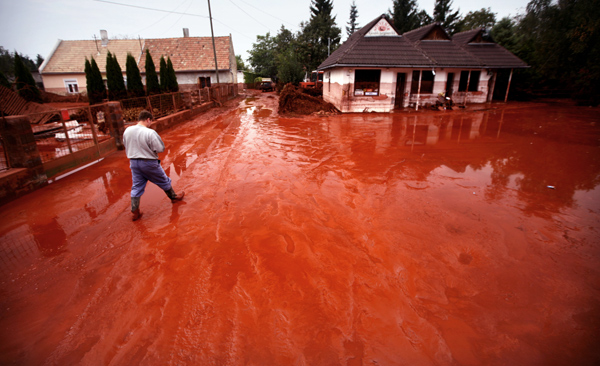 The disastrous chemical accident has been declared Hungary’s largest and most dangerous environmental catastrophe, exceeding by far the 130000 cubic meters of cyanide-tainted water that spilled in 2000 in Baia Mare, Romania. Ten years later, traces of cyanide are still found in the area. It is worth noting that this cyanide was in a liquid form, therefore very quickly carried aways by the river whereas the thick red mud will sit there for years, sipping into the ground and reaching ground waters.
The disastrous chemical accident has been declared Hungary’s largest and most dangerous environmental catastrophe, exceeding by far the 130000 cubic meters of cyanide-tainted water that spilled in 2000 in Baia Mare, Romania. Ten years later, traces of cyanide are still found in the area. It is worth noting that this cyanide was in a liquid form, therefore very quickly carried aways by the river whereas the thick red mud will sit there for years, sipping into the ground and reaching ground waters.
Read More
Jul 06 2010
ALCOA, Arms Industry, Bauxite, Century Aluminum, Economics, India, Mining, Pollution, Repression, Rio Tinto Alcan, Samarendra Das, Vedanta
Out of This Earth: East India Adivasis and the Aluminium Cartel
By Felix Padel and Samarendra Das
Published by Orient BlackSwan
Aluminium is a metal that many take for granted in hundreds of artifacts but fewer understand where it comes from and its real costs. Behind the shining image of aluminium is a dark side of environmental catastrophes, political manipulations and cultural genocide.
Out of This Earth: East India Adivasis and the Aluminium Cartel written by Felix Padel and Samarendra Das is an extraordinary book that explores the aluminium industry over its entire life cycle, from the mining of Bauxite to its various end uses.
With a foreward by Arundathi Roy it focuses on the Adivasis struggle against mining activities in the state of Odisha (former Orissa). There industrialization is imposed under the guise of development, growth and poverty alleviation, a process that has already displaced thousands of people and destroyed tribal society‘s structures. The book traces a hidden history of how one country after another has swallowed promises of prosperity and plunged into a cycle of exploitation and unrepayable debt. One of the real contributions of Out of This Earth is the commendable effort of the authors to painstakingly trace the forces that actually drive and control the global aluminium industry – how it is driven by a cartel that fuses mining companies, investment bankers, government deals, metals traders and arms manufacturers. Read More
Jan 15 2010
Arms Industry, Capitalism, Climate Change, Corruption, Dams, Greenwash, Jason Slade, Pollution, Repression
By Jason Slade
Originally published in the Nor easter
The Spectacle
Environmental issues can oftentimes be very complex. Some issues directly relate to climate change, and some do not. However, it is very important to connect the dots between issues because almost all environmental problems are caused, at their base, by capitalist expansion, commodification and privatization. Corporations have used the climate crisis and growing public concern about environmental issues to their advantage. They have learned to use the rhetoric of environmentalism to justify extremely oppressive projects whose sole purpose is to increase their power and to continue the cycle of production and consumption. Incredibly destructive projects, such as hydrofracture natural gas extraction in Upstate New York, are marketed as clean. This absurd spectacle must be stopped.
In Guy Debord’s Society of the Spectacle, he writes, “The spectacle presents itself simultaneously as all of society, as part of society, and as instrument of unification … The spectacle grasped in its totality is both the result and the project of the existing mode of production. It is not a supplement to the real world, an additional decoration. It is the heart of the unrealism of the real society. In all its specific forms, as information or propaganda, as advertisement or direct entertainment consumption, the spectacle is the present model of socially dominant life … It is the sun which never sets over the empire of modern passivity. It covers the entire surface of the world and bathes endlessly in its own glory.” And now the light of that sun is green. The green spectacle is confronting the climate crisis with hollow solutions presented to us in a pleasant, prefabricated package that can be bought if we can afford them and allow us to pollute in good conscience. In an absurd twist, these corporate false solutions cause the poor, and those who resist these schemes, to be blamed for destroying the planet. “It is not the oil companies who are to blame for climate change, but the poor who do not buy carbon offsets when they travel.” Thus, the climate crisis becomes another way to make money and increase corporate power. Read More
Oct 25 2008
2 Comments
India, Orissa, Pollution
INDIA – Farmers in Hirakud, Orissa are protesting against the Hindalco aluminium smelter plant for emitting poisonous gas, which has damaged their paddy crops spread across 113 acres of land. They have also demanded immediate compensation from the factory management. In an early morning in September farmers in Nuagujatal and Gundurupada village near Hindalco aluminium smelter plant in Hirakud NAC of Sambalpur district, found that their paddy crops had turned from green to yellow. They were surprised to see the change happening so quickly, overnight, and when they looked around similar symptoms were noticed in the trees.
The yellowing had been a regular phenomenon in the area, which occurs every year. This time the factory had released noxious emission, mostly fluoride wastes, when there was a heavy downpour. With the rain water the fumes became toxic rain and damaged the crop, allege agricultural scientists.
Read More
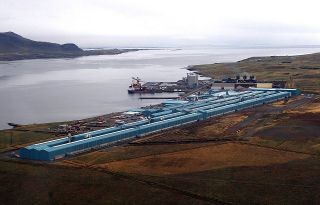
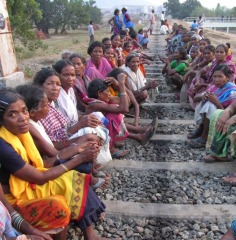

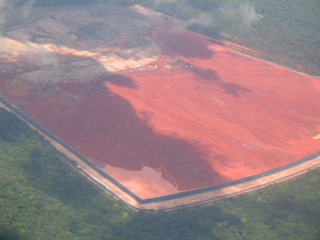
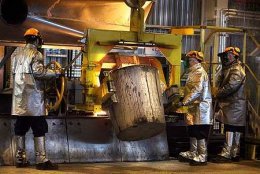
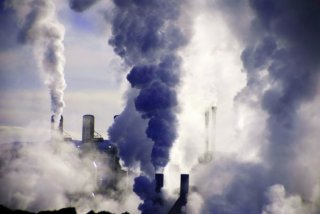
 The disastrous chemical accident has been declared Hungary’s largest and most dangerous environmental catastrophe, exceeding by far the 130000 cubic meters of cyanide-tainted water that spilled in 2000 in Baia Mare, Romania. Ten years later, traces of cyanide are still found in the area. It is worth noting that this cyanide was in a liquid form, therefore very quickly carried aways by the river whereas the thick red mud will sit there for years, sipping into the ground and reaching ground waters.
The disastrous chemical accident has been declared Hungary’s largest and most dangerous environmental catastrophe, exceeding by far the 130000 cubic meters of cyanide-tainted water that spilled in 2000 in Baia Mare, Romania. Ten years later, traces of cyanide are still found in the area. It is worth noting that this cyanide was in a liquid form, therefore very quickly carried aways by the river whereas the thick red mud will sit there for years, sipping into the ground and reaching ground waters.

